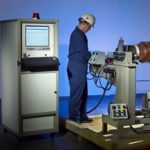The Baker AWA-IV automatically performs repeatable, user-programmable tests to thoroughly assess the strength of a motor’s insulation and circuit. In fact, it is the only high-voltage test instrument that a user can program to perform a specific set of insulation tests prior to being in the field, and then use as programmed in the field. The AWA-IV is also used to assure quality of motor rebuilds or new production motors before they are placed into service.
The Baker AWA-IV is a simple-to-use test instrument with an intuitive, touch-screen user interface. It delivers accurate, repeatable results regardless of the skill level of a given operator. It easily detects problems that low-voltage testers cannot find by performing a comprehensive set of both high- and low-voltage tests.
Results are presented in simple, easy-to-understand graphs and reports that give motor maintenance professionals the information they need to minimize costs and unplanned downtime. The ability to apply identical tests to a given motor over a long period allows trends to be analyzed, revealing the degradation of insulation over the motor’s lifetime. This allows maintenance professionals to predict when a motor may fail, and plan its replacement accordingly.
The AWA-IV offers computer control and waveform monitoring advantages over equivalent manually controlled instruments. The analyser’s embedded computer conducts the tests, stores the results and continuously monitors voltage levels while testing. If the analyser detects a weakness in the insulation during a given test, the test is interrupted, the operator is alerted and all test parameters at the time of the interruption are reported.
The AWA-IV’s benefits can be extended to low-impedance coils, such as armatures, through the use of the Baker ZTX low impedance coil accessory. The ZTX, which includes the ATF5000 commutator probe accessory, allows the AWA-IV to apply surge tests to coils which require higher currents.

In an industrial setting, the consequential cost of failure or unplanned downtime of critical rotating machinery can be significant. The Baker DX series can apply a wide set of off-line electrical tests to assess the condition of motors and coils.
In a motor repair shop, or for new production motors, the Baker DX gives confidence that a motor is correctly wound and insulated, before it’s deployed in the field.
The standards-compliant surge test – a signature feature of Baker testers for decades – is the only test that can safely expose turn-to-turn insulation weaknesses. The Baker DX can find early indications of insulation weakness and faults in windings, between phases, coil-to-coil and in groundwall insulation. It can identify if contamination is impacting insulation strength. It can also detect problems with connections such as feed cable insulation weakness, motor imbalances, opens or high resistance.
The DX’s benefits can be extended to low-impedance coils, such as armatures, through the use of the Baker ZTX low impedance coil accessory. The ZTX, which includes the ATF5000 commutator probe accessory, allows the DX to apply surge tests to coils which require higher currents.
Baker Surveyor DX Software-
Surveyor DX software enables Baker DX operators to use a personal computer to store more test data, generate and view reports across the full spectrum of Baker DX tests, and share and compare analysis with other maintenance personnel using data from multiple analyzers.
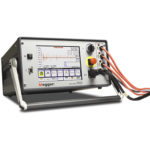
When coupled with Baker static motor analysers (i.e., certain Baker DX and AWA-IV models), the Baker PPX Power Packs extend the insulation testing voltage range. They help verify the condition of insulation on form-wound coils, high voltage AC motors and large DC motors, and are ideal for use in manufacturing, predictive maintenance, and motor rewind and repair settings.In order to test large, high voltage motors that typically drive the critical processes in industry, higher test voltages and currents than those available in portable motor analysers are required. Baker Power Packs (when used in concert with a Baker static motor analyser) verify insulation at voltages up to 40 kV, with up to 2600 A of current available.

The MTR105 is a dedicated Static Motor Tester with Megger’s tried and trusted suite of insulation resistance tests (IR), plus all the great traditional features and reliability of Megger’s testers.
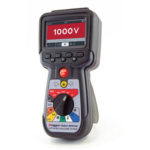
The Baker EXP4000 is a powerful tool, designed for site use, to analyse the motor running under its normal load. It tracks multiple data types to identify trends that indicate potential problems. Voltage and current are measured and a series of parameters are then calculated, including power quality, rotor bar condition, % load, % operating efficiency, average torque value, torque ripple showing variation within process, monitoring of start-up transients (volts, current and torque), and much more.
The EXP4000 enables root-cause analysis, starting with separation of mechanical and electrical issues that may be present in a motor-machine system. By monitoring many different parameters and using advanced software algorithms, the EXP4000 is designed to pinpoint challenges across the system, including those with the power supplied, variable-frequency drive, the motor, and the load placed on the motor. Examples of the wide range of problems it may detect include:
The Baker EP1000 Dynamic Motor Link is an optional accessory which is installed permanently inside the motor control cabinet (MCC), and which provides a low-voltage connection port on the cabinet’s door. A technician can simply connect the EXP4000 to that port without the need to open the cabinet or power down the motor. This provides obvious safety benefits, as well as improved convenience and productivity where a large number of motors need to be monitored.
Through use of the Baker EXP4000, along with a static motor analyser, such as the Baker AWA-IV, maintenance professionals have the means to minimize unexpected failures while maximizing uptime of motors and the machinery that they drive.
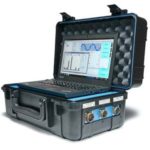
NetEP is a permanently-installed, fully automated machine system monitoring solution. It continuously acquires health and performance data on electric motors and the rotating machine systems they operate. With the Baker NetEP, maintenance professionals can safely gather performance data on critical motors around the clock, 365 days a year. They can monitor the condition of motors and the equipment they drive from the convenience and safety of a central office. The system helps reduce costly unplanned downtime by providing information that improves maintenance decision making and planning. The dashboard display of the NetEP’s associated software clearly shows motors in an alarm condition.
The NetEP goes beyond the capabilities of portable testing by providing a timeline of trend information that maximizes visibility into motor system health and performance. Maintenance professionals can use NetEP to monitor motor system performance from virtually anywhere in the world with a PC using the system’s Web-accessible interface. Motor rewinders, for example, can now offer remote electrical and mechanical monitoring of their customers’ critical machinery.
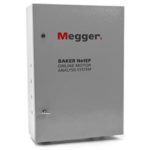
Megger Baker Instruments designs and manufactures electric motor test systems for original equipment manufacturers (OEMs) that help ensure their motors and coils meet or exceed the quality expectations OEMs wish to set with their customers. The Baker WinAST and Baker HV WinAST are semi-custom, fully automated, high-volume electric motor testing units that can test thousands of motors, generators or coils per day, depending upon the size and types of motors, or the testing fixtures used.
These automated stator testers are used to test AC motors ranging in size from fractional to 5000 hp, as well as DC motors up to about 1500 hp. Manufacturers of motor windings, stators, coils, alternators, and rotors use the Baker WinAST to avoid shipping dead-on-arrival (DOA) motors, or products that prematurely fail or malfunction after being placed in service.
Unlike other volume manufacturing test approaches, this system does not require a master winding to perform routine production tests, nor does an operator need to set test voltages or pass/fail limits when production is switched to another motor model. All test parameters are programmed into a master, “known-good” data file, an operation that can be performed in minutes. When a master file is created, the user is prompted for all necessary information about a given product to be tested, and when complete, the file is permanently stored within the 160 GB of system storage.
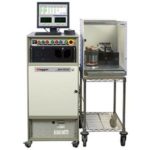
The Baker WinTATS traction armature test system is a reliable, field-proven system for accurate, rapid testing of armatures in motor manufacturing and quality control operations. The fully-automated unit performs the required set of tests that motor manufacturing and rebuild shops need for quality assurance and control. AC hipot, DC hipot, surge and resistance tests are standard.
In operation, an armature to be tested is loaded onto the armature indexing stand. This ruggedized, custom built, armature test fixture enables quick and safe connection of an armature to the system. Since many armatures are heavy and cumbersome, the purpose of this fixture is to provide a quick connection of armatures to the tester and provide a higher degree of safety to the operator.
The armature is rotated by a rubber drive wheel, which is in contact with the armature and is propelled by a computer-controlled stepper motor. Usually, one or two optical sensors are used to sense the commutator slots as the armature rotates. This fixture is designed for years of heavy-duty operation in a manufacturing environment.
